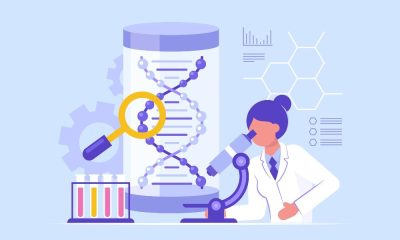News
Target protein in diabetes drug linked to lower risk of Alzheimer’s

Mechanisms associated with a particular diabetes drug can also help to protect against Alzheimer’s disease, a study has reported.
The results of the Karolinska Institutet study published in Neurology on June 2 indicate that the drug’s target protein can be an interesting candidate for the treatment of Alzheimer’s disease.
Alzheimer’s disease is becoming increasingly common, but there are no drugs to affect the course of the disease and the development of new drugs is a slow, costly and complex process.
An alternative strategy is therefore to find already approved drugs that can prove efficacious against the disease and give them a new area of application.
Diabetes drugs have been put forward as possible candidates, but so far the studies that have tested diabetes drugs for Alzheimer’s disease have not produced convincing results.
In the present study, researchers from Karolinska Institutet used genetic methods to study this more closely.
Similar effects
“Genetic variants within or nearby the genes that encode a drug’s target proteins can cause physiological changes similar to the effects of the drug,” said the study’s first author Bowen Tang, doctoral student at the Department of Medical Epidemiology and Biostatistics, Karolinska Institutet.
“We utilise such variants to test the repurposing potential of already approved drugs.”
The researchers began by identifying genetic variants that mimic the pharmacological effect of diabetes drugs, namely lowering blood glucose.
This was done through an analysis of data from over 300,000 participants in the UK Biobank register.
The analysis identified variants in two genes that together code for the target protein of a class of diabetes drug called sulphonylureas.
The researchers validated these variants by showing their association with, amongst other phenomena, higher insulin release, lower type two diabetes risk and higher BMI, which is consistent with the drug’s effects.
The researchers then examined the link between the identified genetic variants and the risk for Alzheimer’s disease.
They did this by analysing data collected previously from over 24,000 people with Alzheimer’s disease and 55,000 controls.
They found that the genetic variants in the sulphonylurea genes were linked to a lower risk of Alzheimer’s disease.
In the brain
“Our results suggest that the target protein of sulphonylureas, the KATP channel, may be a therapeutic target for the treatment and prevention of Alzheimer’s disease,” said the study’s last author Sara Hägg, docent at the Department of Medical Epidemiology and Biostatistics, Karolinska Institutet.
“This protein is expressed in the pancreas, but also in the brain, and further studies are needed to fully understand the underlying biology.”
The method of analysis applied in the study is called Mendelian randomisation which uses knowledge of genetic variants in individuals as a kind of natural randomisation, not unlike a randomised clinical study.
Individuals born with certain protective variants that mimic the effect of a certain drug can therefore be studied for their association to a disease.
The study was financed by the Swedish Research Council, a KI-NIH doctoral grant, Karolinska Institutet Foundation, Karolinska Institutet’s grant for the Strategic Research Area in Epidemiology (SFOepi), King Gustaf V and Queen Victoria’s Foundation of Freemasons and the National Institutes of Health.
The researchers report no potential conflicts of interest.
News
Weight loss jabs my only temporarily reduce ‘food noise,’ study finds
News
Childhood loneliness linked to increased risk of dementia, study finds

Childhood loneliness increases the risk of dementia in later life, according to new research.
Adults who recalled being lonely and without a close friend in childhood faced a 41 per cent higher risk of developing dementia, even if they were no longer lonely as adults.
People who frequently felt lonely without close friends during youth showed accelerated cognitive decline — a worsening of memory and thinking — and started middle age with lower scores on these skills.
Researchers from universities in China, Australia and the US, including Harvard and Boston universities, analysed data from 13,592 Chinese adults tracked from June 2011 to December 2018.
The critical factor was the subjective feeling of loneliness itself. Those who reported often feeling lonely as children had a 51 per cent higher dementia risk, even if some had close friends.
However, those who only lacked close friends but did not feel lonely showed no significant difference in risk.
Nearly half of roughly 1,400 adults in the study reported being lonely and without close friends during childhood.
The 4.2 per cent who experienced both faced the highest risk of cognitive decline.
The link to dementia remained strong even for people who were no longer lonely in adulthood, suggesting early-life isolation can have lasting effects on brain health.
During childhood, the brain develops rapidly and is vulnerable to harm. Loneliness acts as a chronic stressor, flooding the developing brain with harmful hormones that can damage memory centres, and it reduces stimulation from social play and peer interaction that helps build robust neural networks.
A separate 2024 study of more than 10,000 older adults found that specific childhood hardships — including poverty, disruptive home environments or parental addiction — were directly linked to poorer cognitive function later in life.
Youth loneliness appears to be rising, partly linked to widespread social media use.
Among girls, 64 per cent aged five to seven, 67 per cent aged eight to 10, and 73 per cent aged 11 to 13 reported feelings of loneliness last year. More than a quarter of boys aged 11 to 17 in the US report feeling lonely.
Children face growing social isolation, with one in four Americans now eating every meal alone — a rate that has surged by over 50 per cent since 2003. Sharing meals with friends and family helps build bonds and positive memories in youth.
Fewer children are playing outside or joining team sports.
A recent study reported that one in three children do not play outside on school days, and one in five do not do so even at weekends.
The 2024 research found a direct, dose-dependent relationship between childhood adversity and cognitive problems in adults — the greater the early trauma, the greater the later risk.
For each significant increase in early trauma, individuals faced an eight per cent higher risk of daily memory issues and scored lower on objective tests of mental speed and focus.
Insights
Don’t miss you essential monthly agetech update

Your essential monthly update on agetech’s progress
Welcome to your monthly snapshot of the facts, figures, opinions, trends and challenges shaping the development of agetech.
Our new monthly tracker report aims to provide an concise update for busy agetech professionals on the many factors influencing your work.
Here you will find a concise breakdown of deals, developments and opportunities from the last 30 days; and insight and opinion from leading thinkers in the field.
We hope you find something useful and/or inspiring below – and welcome any feedback about what else you’d like to see included.

 News2 months ago
News2 months agoKey change to urine could be early warning sign of dementia, researchers say

 News4 weeks ago
News4 weeks agoResearchers find new drug extends lifespan

 News1 week ago
News1 week agoListening to music can reduce dementia risk, study reveals

 Technology1 month ago
Technology1 month agoNew technique can track Alzheimer’s in real time

 News3 weeks ago
News3 weeks agoMen need twice as much exercise as women to cut heart disease risk, study finds

 News23 hours ago
News23 hours agoWeight loss jabs my only temporarily reduce ‘food noise,’ study finds

 News1 month ago
News1 month agoNew US$6.5m centre targets healthy ageing

 News2 weeks ago
News2 weeks agoJust 3,000 steps a day may slow Alzheimer’s progression, study finds


































